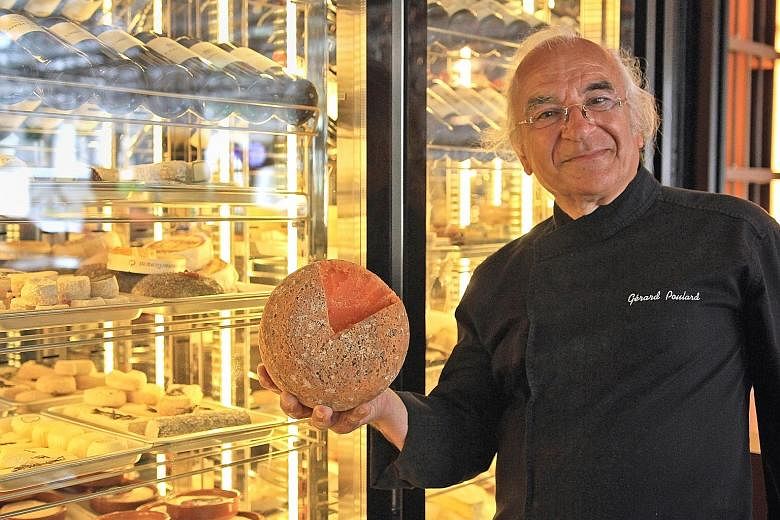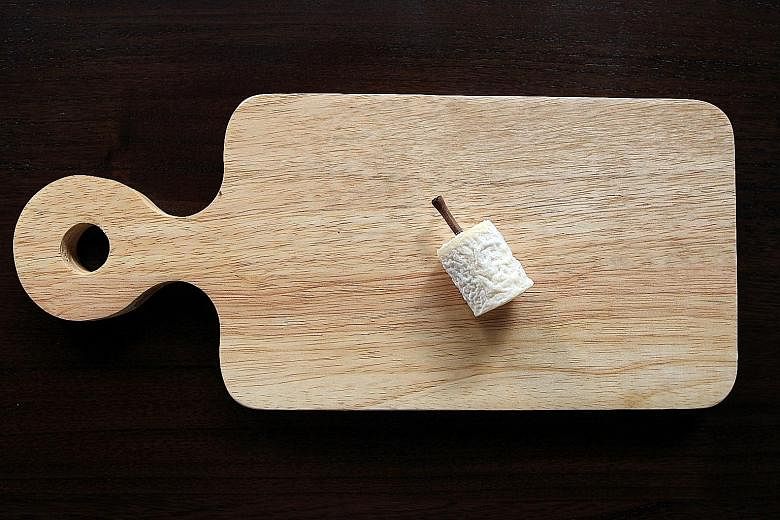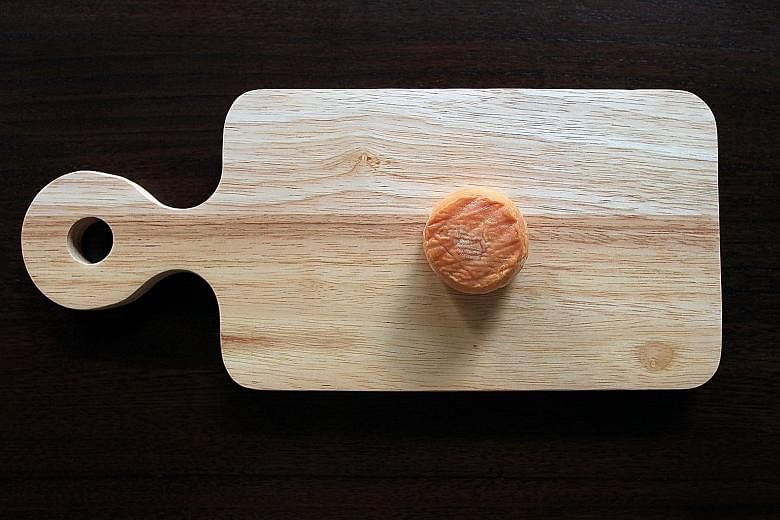Over the past three decades, French cheese master Gerard Poulard has amassed a smorgasbord of about 1,000 cheeses, made from goat, sheep and cow milk.
To unearth them, the 70-year-old travels with his son to small, family- owned farms that dot the French countryside. The duo, who both have pilot licences, rent a small plane for their cheese-hunting trips, which used to happen every other weekend.
Mr Poulard tells The Straits Times in French through a translator: "From the plane, we can look out for flocks of sheep, cows and goats in the fields. These remote farms that rear these animals are likely to produce cheese."
One of his trips almost got him in trouble with the law.
Chuckling at a memory, he says: "Once, a farmer almost called the police as he was wondering why we were making so much noise by hovering our plane above his farm."
These trips happen less frequently these days, as he has built up a solid network with cheesemakers around the country.
Mr Poulard brought about 150kg of 50 varieties of cheeses for a five-day showcase at Ginett Restaurant & Wine Bar in Hotel G in Middle Road.
Some rare ones include the Trappist cheese, a semi-hard cow's-milk cheese made by Trappist monks, and Perail des Cabasses, which is made from raw sheep's milk from Aveyron in southern France.
Mr Poulard is no stranger to the local food scene. The long-time cheese maitre has been here about 20 times for cheese events at hotels and restaurants. In the 1990s, he helmed an annual cheese event in the now-defunct Le Meridien Hotel in Orchard Road.
He says: "I love Singapore as it is a unique place that is at the crossroads of diverse cultures. I like Singapore food, from mee pok to Hainanese chicken rice."
The former cheese maitre of the now-defunct Le Meridien Montparnasse in Paris notes that diners here have come a long way in their appreciation of cheese.
"Diners used to flinch at the sight of more pungent cheeses such as blue cheese. It was like bringing durian into Paris," he says with a laugh. "These days, people in Paris are no longer scared of durians. And neither are Singaporeans of cheese as their tastebuds have evolved and they are more adventurous and want to discover new types of cheese."
At a media event here, the sprightly Mr Poulard, who sported a silver-haired ponytail, bantered easily and playfully tossed a ball-shaped Mimolette cheese up in the air during a photo shoot.
On hearing that some diners are familiar only with common types of pasteurised cheeses such as brie and mozzarella, he shakes his head disapprovingly.
"Pasteurised cheese has almost no taste and smell," he explains. "The most important thing when you are eating cheese is not to smell what you eat, but to taste what you smell."
He adds that making pasteurised cheese has become an industrialised process, whereas having cheeses made with raw milk is "enjoying a slice of culture" made by predominantly female cheesemakers in France.
The age-old practice of men working in the fields in dairy farms and their wives staying home to make dairy products such as cheese and butter still exists in rural France.
So what is one of his favourite cheeses?
Despite being a champion for French cheeses, he sheepishly admits that it is an Italian cheese - Parmigiano-Reggiano that has been aged for four years.
He exclaims: "The flavour, texture, smell are well balanced and this is perfection in cheese."
A highly sought-after cheese consultant, Mr Poulard travels six times a year for events around the world to share his encyclopaedic knowledge, from the breed of animals behind cheeses to pairing cheeses with tea, wines and fruit.
These days, he says, "his boss" is his son Olivier, 42, who runs Poulard Paris, which distributes cheeses and organises beer and cheese events. He also owns French beer company Riviera.
What keeps Mr Poulard, who has been bestowed the Order of Agricultural Merit by the French government, excited about his job?
The grandfather of three says with a twinkle in his eye: "It is my passion to travel around the world to share about French culture. Cheese, like wine and baguette, is in our DNA and is our way of life."
His favourite rare French cheeses
ST DOMNIN DE PROVENCE PETIT

Type: Semi-soft
Milk: Goat
What: This floral-scented cheese from Provence is infused with sprigs of lavender.
The cheese is produced in a farm that has 230 goats grazing the surrounding hills, which are carpeted with fragrant plants such as thyme. Biting into this cheese is like entering a flower shop as it is perfumed with lavender. This milky and slightly tart cheese has a soft, white bloomy rind, which hardens and becomes crumbly when aged.
Best spread on bread or crackers and paired with sauvignon blanc.
BOUCHON SARMENT D'AMOUR

Type: Soft
Milk: Goat
What:This cheese is shaped like a wine cork and has a grapevine twig inserted in the middle - which makes it easier to pick up and eat.
Made in Sancerre in the Loire Valley in central France, this cheese has a mild goat flavour.
It is known as the "two-in-one cheese" as it has a marshmallow-like interior with a rich and creamy taste, while the crust has a slightly stronger flavour.
ROVETHYM HAUTE PROVENCE

Type: Semi-soft
Milk: Goat
What: The name of this distinctively shaped cheese is a portmanteau of the words thyme and Rove, a breed of goat that grazes herb-filled pastures in the Alps of Provence in south-eastern France.
This cheese is not too creamy and gets saltier with age. It has a soft white rind and is garnished with a sprig of thyme.
COEUR DE NEUFCHATEL

Type: Soft
Milk: Cow
What: This heart-shaped cheese comes from Neufchatel, Normandy, in northern France. Legend has it that the young maidens of Neufchatel offered this cheese, which reminded them of angels' wings, in mediaeval times to their English conquerors.
This cheese resembles the soft and creamy Camembert and Chaource cheeses, but tastes saltier and sharper.
It is best paired with crusty bread and red wines.
TROU DU CRU BERTHAUT

Type: Soft
Milk: Cow
What: Hailing from Burgundy, this ivory-yellow cheese is strong, pungent and has an edible orange rind.
During its four-week maturation period, it is washed with Marc de Bourgogne, a liquor that is distilled from pressed grapes during the wine-making process.
This gives the cheese a straw-like flavour.







